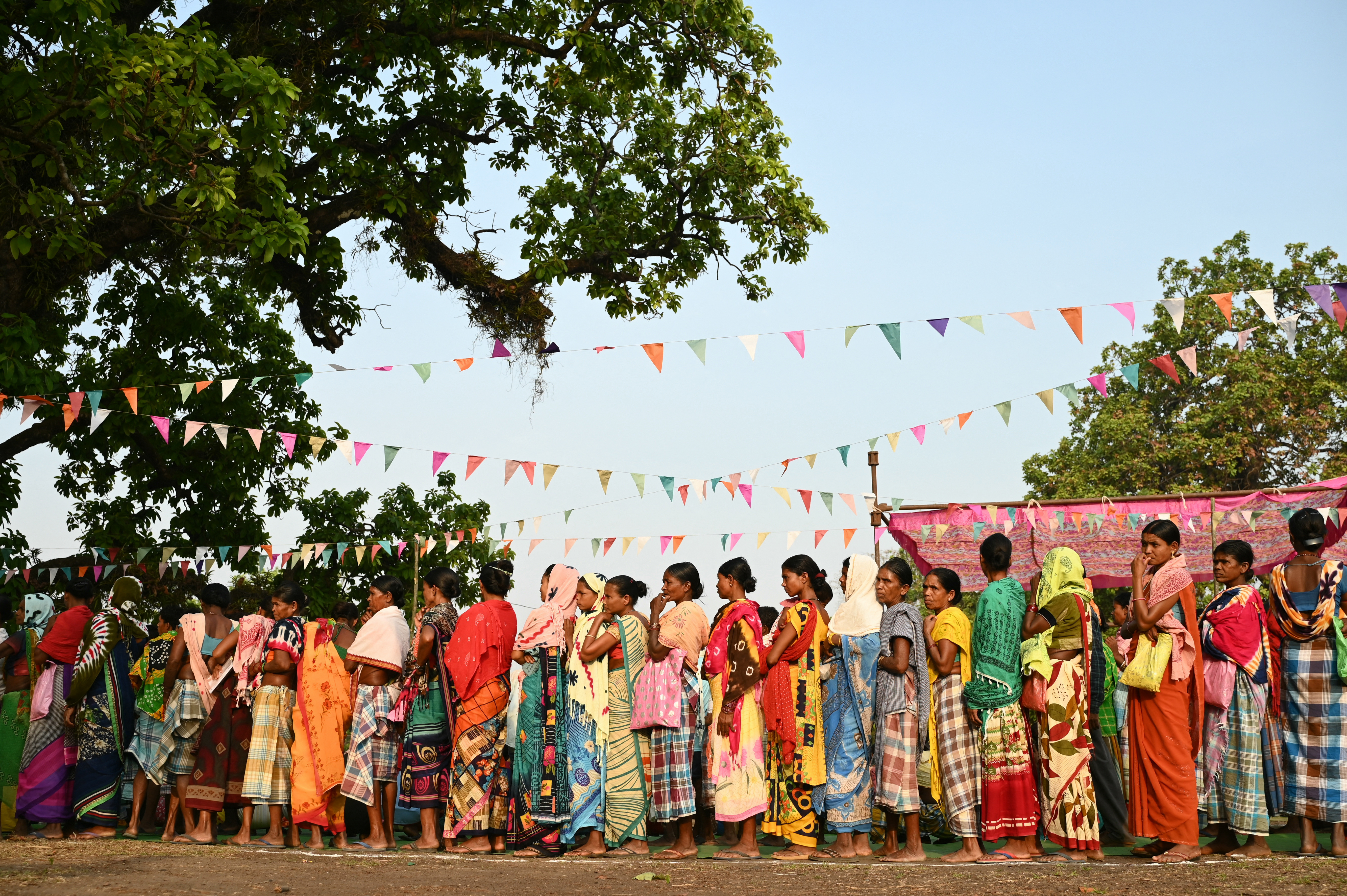India, History of. India has been home to several major empires and civilizations. Through the centuries, travelers to India described it as a land rich in gold, spices, textiles, and other valuables, and India became fabled for its wealth. Eventually, it attracted European traders, and in the late 1700’s, India came under British rule. In 1947, after a long struggle for freedom, India became an independent country.
Earliest times.
People have lived in what is now India for at least 200,000 years. About 4,600 years ago, a civilization began to flourish in the Indus Valley in what are now western India and Pakistan. Archaeological excavations in the early 1920’s uncovered extensive ruins of two cities named Harappa and Mohenjo-Daro (also spelled Moenjodaro).
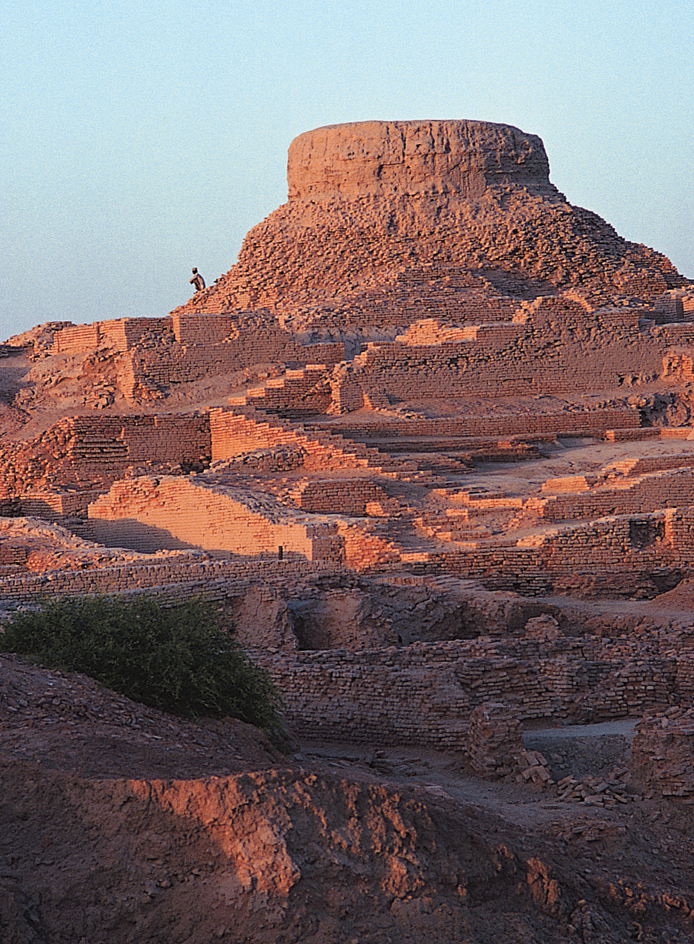
The people of Harappa, Mohenjo-Daro, and other Indus Valley cities had a system of writing. However, scholars have not yet succeeded in deciphering this script. The Indus Valley people also had systems of counting, measuring, and weighing. From about 1900 B.C. to 1700 B.C., the Indus Valley civilization gradually broke up. Scholars believe that changing river patterns, including a series of floods, may have caused the end of the culture.
The Aryans.
About 1500 B.C., groups of warlike people left their homes in central Asia, possibly near the Caucasus Mountains, and came to India. These people called themselves arya (kinsmen or nobles). They are now known as the Aryans.
When the Aryans arrived in India, they found people with an advanced civilization living there. These people, called the Dravidians, lived in towns and grew crops. The Aryans gradually conquered the Dravidians and drove some of them southward. Eventually, the Aryans extended their rule over all of India except the south.
The Aryans tended sheep, goats, cows, and horses. They measured their wealth in herds of cattle. Over time, the Aryans settled into villages. Each village or group of villages was led by a headman and council.
Over many centuries, the caste system became established. The Brahmans—the priests—were the highest caste and the Shudras, who may have been Dravidians, were the lowest. The Brahmans perfected Sanskrit, the language of the Aryans; conducted elaborate rituals and sacrifices; and passed sacred knowledge from one generation to another. Beginning about 1400 B.C., the earliest known Hindu scriptures—the Vedas—were composed. The most important Hindu sacred writings, called the Upanishads, appeared between 800 and 600 B.C.
In the 500’s and 400’s B.C., two religions were founded in India. The great religious and social reformer Siddhartha Gautama, who became known as Buddha (Enlightened One), founded Buddhism. Another reformer, Mahavira, organized Jainism. Both religions rejected the authority of the Vedas and the Brahmans, and both spread rapidly throughout India.
Persian and Greek invasions.
About 518 B.C., Persians gained control of the Gandhara region in the northwest, now in Pakistan. Alexander the Great of Macedonia led his Greek army into India in 326 B.C., but he went only as far as the Beas River in the northwest. He wanted to push eastward to the Ganges River, but his troops, tired and worn out by disease, refused to go farther. Alexander left India and named some of his generals as satraps (governors) of the conquered provinces. In a few years, Indian forces drove most of the satraps out.
The Mauryan Empire
was established by Chandragupta Maurya about 324 B.C. By the end of Chandragupta Maurya’s rule in about 298 B.C., the empire extended over nearly all of northern India and into what are now Afghanistan and parts of central Asia.
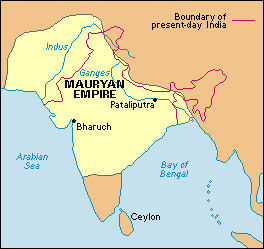
Chandragupta Maurya’s grandson Ashoka became one of India’s most famous emperors. He ruled from about 272 to 232 B.C. In 261 B.C., Ashoka conquered the kingdom of Kalinga (now Odisha). The bloodshed caused by his war of conquest left Ashoka stricken with sorrow and regret. Ashoka gave up war.
Ashoka spent the rest of his life trying to spread a message, based on Buddhist teachings, that emphasized nonviolence and the importance of duty. He sent members of his family as Buddhist missionaries to other parts of India and to what is now Sri Lanka. Ashoka had laws and moral teachings carved on great pillars that were installed throughout his kingdom. India’s state emblem, a group of lions, is taken from one of these pillars.
The Mauryan Empire began to break up after the death of Ashoka in 232 B.C. The empire ended about 185 B.C. For about the next 500 years, groups of central Asian peoples, including the Scythians and the Kushans, moved into northern India. The Kushans established a dynasty in northern India around A.D. 50.
The golden age.
Indian emperors of the Gupta dynasty reunited northern India about 320. Gupta territory eventually extended to what is now Afghanistan in the northwest and to the Vindhya mountains in the south. The Gupta Empire, which lasted until about 500, is often referred to as India’s “golden age.” Indian art, literature, mathematics, philosophy, and science achieved great heights under the Guptas, especially during the reign of Chandragupta II, who ruled from about 375 to about 415. India’s most famous dramatist and poet, Kalidasa, wrote works of great charm and beauty in this period. The finest frescoes at Ajanta were also painted at this time, and many Hindu temples were built. A system of medicine called Ayurveda also developed about this time.
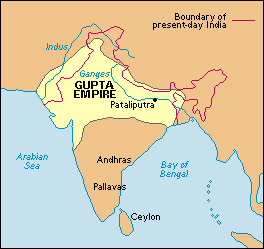
Southern India.
From about 50 B.C. to about the A.D. 1000’s, several dynasties competed for control of southern India and established a great civilization there. These dynasties included the Satavahanas, the Cholas, and the Pallavas. Southern India forged trading links with Southeast Asia that lasted for centuries. Indian traders and other voyagers spread Indian culture throughout Southeast Asia.
Period of invasions.
From about 455 to the early 1500’s, armies from what are now Afghanistan, central Asia, and Iran invaded India. First, the Huns invaded from central Asia. Muslim armies came from Arabia in the early 700’s. Mahmud of Ghazni, a warrior from Afghanistan, began a series of 17 raids into India about 1000. During these attacks, Mahmud destroyed Hindu temples and looted Indian cities.
In 1206, the Muslim general Qutb ud-Din Aybak proclaimed himself sultan (ruler) of northern India and established the Delhi Sultanate. In 1398, the armies of the central Asian leader Timur, also known as Tamerlane, swept over India. Timur sacked Delhi before returning to his capital at Samarqand (Samarkand) in what is now Uzbekistan. After Timur’s attack, the Delhi Sultanate began to break apart.
The Mughal Empire.
In 1526, a central Asian leader named Babur defeated Ibrahim Lodi, the last sultan of Delhi, at the Battle of Panipat. Babur, a descendant of both Timur and the Mongol conqueror Genghis Khan, then established the Mughal Empire in India. Babur ruled until 1530 and conquered much of northern India.
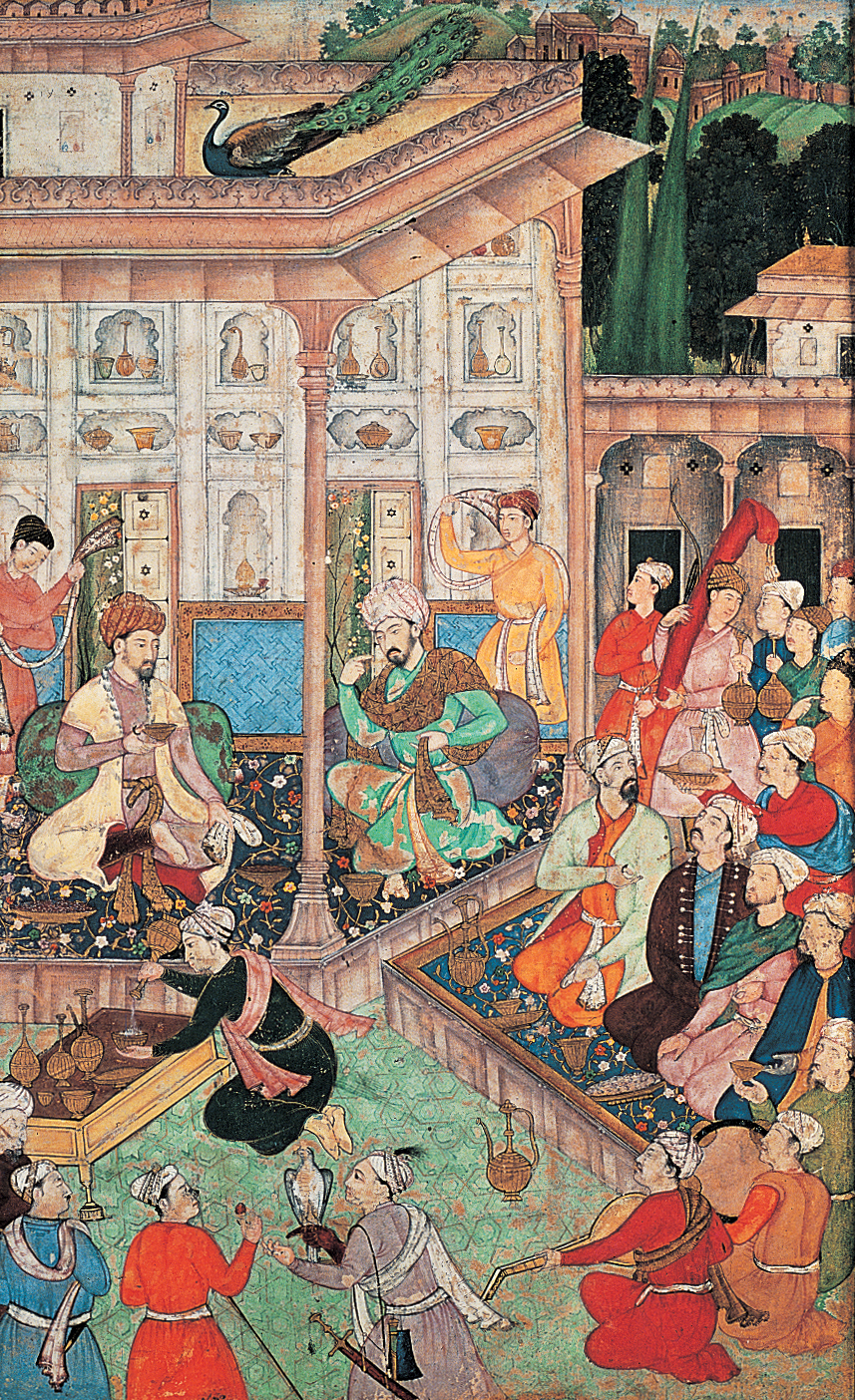
Babur’s grandson Akbar became the greatest Mughal emperor. He ruled from 1556 to 1605. He expanded his empire as far west as what is now Afghanistan and as far south as the Godavari River. Akbar was a tolerant ruler. A Muslim, he won over the Hindus of India by making many of their leaders government administrators and military commanders, and by giving them honors. The Mughal Empire under Akbar was among the most powerful in the world at that time.
Akbar’s grandson Shah Jahan, who ruled from 1628 to 1658, built a new capital in Delhi. He was also responsible for the construction of the Taj Mahal at Agra and many other great buildings.

Aurangzeb, one of Shah Jahan’s sons, became head of the Mughal Empire in 1658. Aurangzeb was a strict Muslim and a harsh ruler. He reimposed a tax on Hindus that had been abolished by Akbar. Hindus hold him responsible for destroying many Hindu temples and trying to forcibly convert Hindus to Islam. His policies caused many revolts. Under the Hindu leader Shivaji, the Marathas of western India launched attacks against Aurangzeb’s empire. Many local leaders in the south also rebelled. Partly as a result of Aurangzeb’s rule and his costly wars, the Mughal Empire began to fall apart.
The coming of the Europeans.
The first European explorer to reach India was Vasco da Gama of Portugal. He arrived in Kozhikode (also known as Calicut) in 1498. At the time, Portugal was challenging Turkish Muslims and traders from Italian city-states for control over the European trade with Asian countries in silk, spices, and other highly valued goods. The Portuguese gained control over Goa and some other areas on the western coast of India.
In 1600, Queen Elizabeth I of England (later part of the United Kingdom) granted a charter for the formation of a company to open trade with India and East Asia. This company, the East India Company, got permission from the Mughal Emperor Jahangir, Akbar’s son, to trade in India. The company soon set up trading posts and forts at Bombay (Mumbai), Calcutta (Kolkata), and Madras (Chennai). During the 1600’s, the English became the leading European power in India. Meanwhile, the French established a trading post at Pondicherry (now Puducherry).
The rise of the East India Company.
By the mid-1700’s, little remained of the Mughal Empire, and there was no effective central power. In these circumstances, the Europeans in India prospered. The East India Company expanded its trade and increased its political power. It also began collecting taxes in some regions. When Indian rulers refused to agree to the company’s terms, the company used force against them.
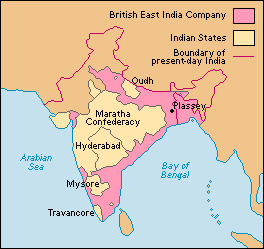
At the Battle of Plassey in 1757, the forces of Robert Clive, an agent of the East India Company, defeated the army of the nawab (Mughal governor) of Bengal. Most historians regard this British victory as the starting point of the British Empire in India, though at that time, most of the country still remained under the rule of Indian princes. Over the next 100 years, however, British political influence and territorial control expanded. In 1774, Warren Hastings was appointed the company’s first governor general of India.
The Indian Rebellion.
Through the years, resentment against British rule grew, especially in the north. Land taxes imposed by the British caused many difficulties for farmers. Large numbers of people went hungry. British land reforms took away land from many Indian people. In addition, many Indians resented what they regarded as a growing British interference in Indian customs and religion.
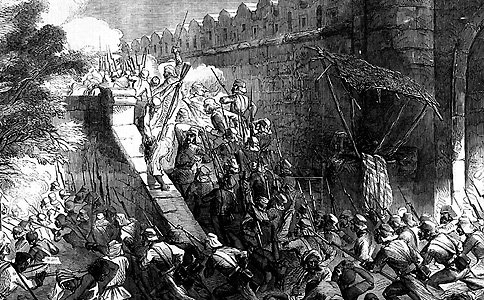
Resentment against the British led to many small rebellions and, in 1857, to a widespread uprising. The 1857 rebellion, sometimes called the Sepoy Rebellion or Sepoy Mutiny, began at an army base in Meerut, near Delhi. There, Indian soldiers called sepoys revolted after British officers instructed them to bite open rifle cartridges believed to have been greased with cow and hog fat. Both Hindus and Muslims objected to the order. The religious beliefs of the Hindu sepoys forbade them to eat beef, and the Muslim sepoys could not eat pork.
The Indian Rebellion quickly spread from Meerut to the rest of northern and central India. However, the rebels were poorly organized, had few weapons, and lacked good leadership. By 1859, they had been defeated. Although the rebellion had failed, the British had faced a serious threat to their rule.
British India.
In 1858, the British government decided to govern India directly. This direct rule is often called the British Raj. Raj means rule or administration. Parliament took control of the East India Company’s Indian possessions, which became known as British India. In most other parts of India, called the princely, or native, states, the British governed indirectly, through local rulers. A few small areas of coastal land remained French or Portuguese colonies until the mid-1900’s.
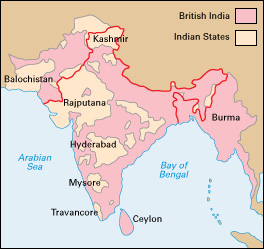
The British monarch appointed an official called a viceroy to govern British India. An executive council of five members—all British and all appointed by the monarch—helped the viceroy. The viceroy appointed from 6 to 12 additional members, who met together with the executive council to form a legislative council. A few Indians could serve on the legislative council.
British India was divided into several provinces. An appointed governor or lieutenant governor headed each province. The provinces also had their own executive council and legislative council.
The United Kingdom placed a representative, called a resident, in each princely state. The resident advised the local prince about political and economic matters. The local prince had no power to make laws relating to foreign affairs, defense, relations with other princely states, and certain other matters. In internal affairs, however, the local prince generally had complete authority.
In 1877, Queen Victoria of the United Kingdom became Empress of India. Although the British did not further expand their territory within India, they were involved in several wars in which they used Indian troops. Indian troops serving under British officers fought the Second Afghan War (1878-1881), which helped establish India’s boundary with Afghanistan. British India defeated the Burmese in the Third Burmese War (1885). Burma (now Myanmar) then became a province of India. It remained a part of India until 1937.
In the second half of the 1800’s, the British built railroad, telephone, and telegraph systems in India. They also established universities. Although the British enlarged the Indian irrigation system, agricultural production improved only slightly. Poverty levels remained high. The British spent little money on elementary education and did little to promote industrialization.
Rise of Indian nationalism.
Indians did not generally feel content about British rule in India. Indians lacked equal job opportunities. They were not allowed to advance to high positions in government service or to become officers in the army. In 1885, a number of Indian lawyers and professionals formed the Indian National Congress. Members of the organization belonged to various religions and came from all parts of India. Congress members debated political and economic reforms, the future of India, and ways for Indians to achieve equal status with the British.

Some Muslims believed the Indian National Congress was a Hindu organization aiming for Hindu rule. In 1906, several Muslim leaders, encouraged by the British, formed the All-India Muslim League. Members of the organization sought to give the Muslims a voice in political affairs. However, most Muslims continued to support the Indian National Congress.
In 1905, the British divided the state of Bengal into separate Hindu and Muslim sections. Indians protested this action with a boycott of British goods and a series of bombings and shootings. In an effort to stop the violence, the British introduced the Morley-Minto Reforms of 1909. These reforms enlarged the viceroy’s executive council to include an Indian. They also allowed Indians to elect representatives to the provincial legislative councils. In 1911, the British reunited Bengal.
When World War I broke out in 1914, the United Kingdom declared that India was also at war with Germany. Indian troops fought in many parts of the world. In return for support, the British promised more reforms and agreed to let Indians have a greater role in political affairs. Nevertheless, protests against the British continued.
In March 1919, the British passed the Rowlatt Acts to try to control protests in India. The acts attempted to restrict the political liberties and rights of Indians, including the right to trial by jury. But demonstrations against the government increased in response to the acts.
On April 13, 1919, thousands of Indians assembled in an enclosed area in Amritsar. Troops entered the meeting place and blocked the entrance. The British commander then ordered the soldiers to open fire on the unarmed crowd. The shots killed about 400 people and wounded about 1,200. This event, called the Amritsar Massacre, proved to be a turning point. From then on, Indians demanded complete independence from British rule. The British promised more reforms, but at the same time, they tried to crush the independence movement.
The Montagu-Chelmsford Reforms were passed in late 1919 and went into full effect in 1921. The reforms increased the powers of the provincial legislative councils, where Indians were most active. The central legislative council was replaced by a legislature with most of its members elected. However, the viceroy and the governors still had the right to veto any bill. The Indians did not believe the reforms gave them enough power.
By 1920, Mohandas K. Gandhi had become a leader in the Indian independence movement and in the Indian National Congress, which had become the most important Indian political organization. Gandhi persuaded the Congress to adopt his program of nonviolent disobedience, also known as nonviolent noncooperation. Gandhi’s program asked Indians to boycott British goods, to refuse to pay taxes, and to stop using British schools, courts, and government services. As a result, some Indians gave up well-paying jobs that required them to cooperate with the British. Gandhi changed the Indian National Congress from a small party of educated men to a mass party with millions of followers.
New Constitution.
In 1930, Gandhi led hundreds of followers on a 240-mile (386-kilometer) march to the sea, where they made salt from seawater. This action was a protest against the Salt Acts, which made it a crime to possess salt not bought from the government. The salt march and other acts of civil disobedience in the early 1930’s led the British to give the Indian people more political power. In 1931, Gandhi and the viceroy, Lord Irwin, signed an agreement. Gandhi agreed to give up his campaign of civil disobedience. The British agreed to release thousands of political prisoners.
Loading the player...Dandi march
The Government of India Act of 1935 created a new constitution. This constitution gave provincial legislatures control over lawmaking in the provinces. It also increased the representation of Indians in all branches of government. However, the viceroy and the governors still kept their veto power over all bills, and the government controlled finances. As a result, many important changes that Indians wanted were never approved by the government.
Meanwhile, the Muslim League had become more politically active. In 1934, Mohammad Ali Jinnah, who had been an important Congress leader, was chosen to head the Muslim League. Under Jinnah’s leadership, the league won a number of seats in the provincial legislatures, and membership increased rapidly. In the provincial elections of 1937, however, most Muslims supported the Indian National Congress or local parties.
Jinnah increased his political activity and declared that the Congress could not speak for Muslims. In 1940, he demanded independence for the northwestern and northeastern areas of India, where the majority of the people were Muslims. The name Pakistan, which means land of the pure in Urdu, came to be used for Jinnah’s proposed Muslim homelands.
World War II (1939-1945).
The United Kingdom declared war on Germany on Sept. 3, 1939. As it had done in World War I, the British again said that India was also at war with Germany. Indian leaders were angered because they had not been consulted. They continued to demand independence. The British promised independence for India after the war. But members of the Indian National Congress demanded immediate self-government instead, and they refused to support the war effort.
Nevertheless, India was already helping the United Kingdom. Indian troops fought in Africa and the Middle East. Indian factories produced supplies for the British and Allied armies. The British exported coffee, tea, rice, and wheat from India to Allied nations. The export of these products contributed in part to the Bengal famine of 1943, in which about 3 million Indians died.
In December 1941, Japan entered the war on Germany’s side. Within a few months, Japanese troops had captured Burma. The Japanese invaded eastern India in March 1944. Many thousands of Indian troops decided to aid the Japanese in the hope of driving the British out of India. These soldiers, most of whom had been captured by the Japanese when they seized Burma, called themselves the Indian National Army. But British and Indian troops soon drove them back.
During the war, the United Kingdom continued to hold talks with the Indian National Congress. In a final effort to free India of the British, Gandhi launched another civil disobedience campaign, called the Quit India Movement, in August 1942. In response, the British jailed all Congress leaders for the rest of the war. The Muslim League, on the other hand, cooperated with the British during the war, with the understanding that their demands for a separate nation would receive serious consideration.
Independence and partition.
At the conclusion of the war in 1945, Congress leaders were released and negotiations for independence were resumed. The British declared early in 1946 that they would grant India independence if Indian political leaders could agree among themselves on a form of government. The United Kingdom sent a special Cabinet mission to India, but the Congress and Muslim League could not settle their differences.
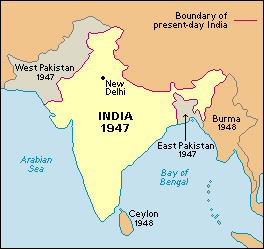
To show its strength and to warn the British not to make a separate agreement with the Congress, the Muslim League declared Aug. 16, 1946, as Direct Action Day. On that day, Muslims held nationwide demonstrations calling for the establishment of Pakistan. Bloody rioting broke out between Muslims and Hindus in Calcutta (now Kolkata). Similar violence later occurred elsewhere in India.
In 1947, Indian and British leaders agreed to partition (divide) the country into India and Pakistan. They saw no other way of bringing to an end the violence between Hindus and Muslims.
India became an independent nation on Aug. 15, 1947. Pakistan had become an independent nation the day before. Partition was accompanied by more violence and bloodshed. More than 10 million people became refugees, as Hindus and Sikhs in Pakistan fled to India, and Muslims in India fled to Pakistan. About half a million people were killed in Hindu-Muslim riots.
Loading the player...India becomes a republic
Gandhi also fell victim to violence. On Jan. 30, 1948, while on his way to a prayer meeting in New Delhi, he was assassinated. A Hindu fanatic who hated Gandhi for his tolerance toward Muslims and disagreed with Gandhi’s policy of nonviolence shot him to death.
Although British India had become partitioned, an agreement also had to be reached with the princely states. Most local rulers agreed to merge their states into India. In return, the Indian government offered them annual payments. A few princely states joined Pakistan.
One state that initially merged into neither India nor Pakistan was Kashmir. Its ruler was Hindu, but the majority of its people were Muslims. Pakistani Muslims launched an invasion to take Kashmir by force, and Pakistan laid claim to the state. Kashmir’s ruler responded by seeking India’s protection and by making Kashmir part of India. The war between India and Pakistan lasted until 1949, when the United Nations (UN) arranged a cease-fire and set up a truce line. See Kashmir. 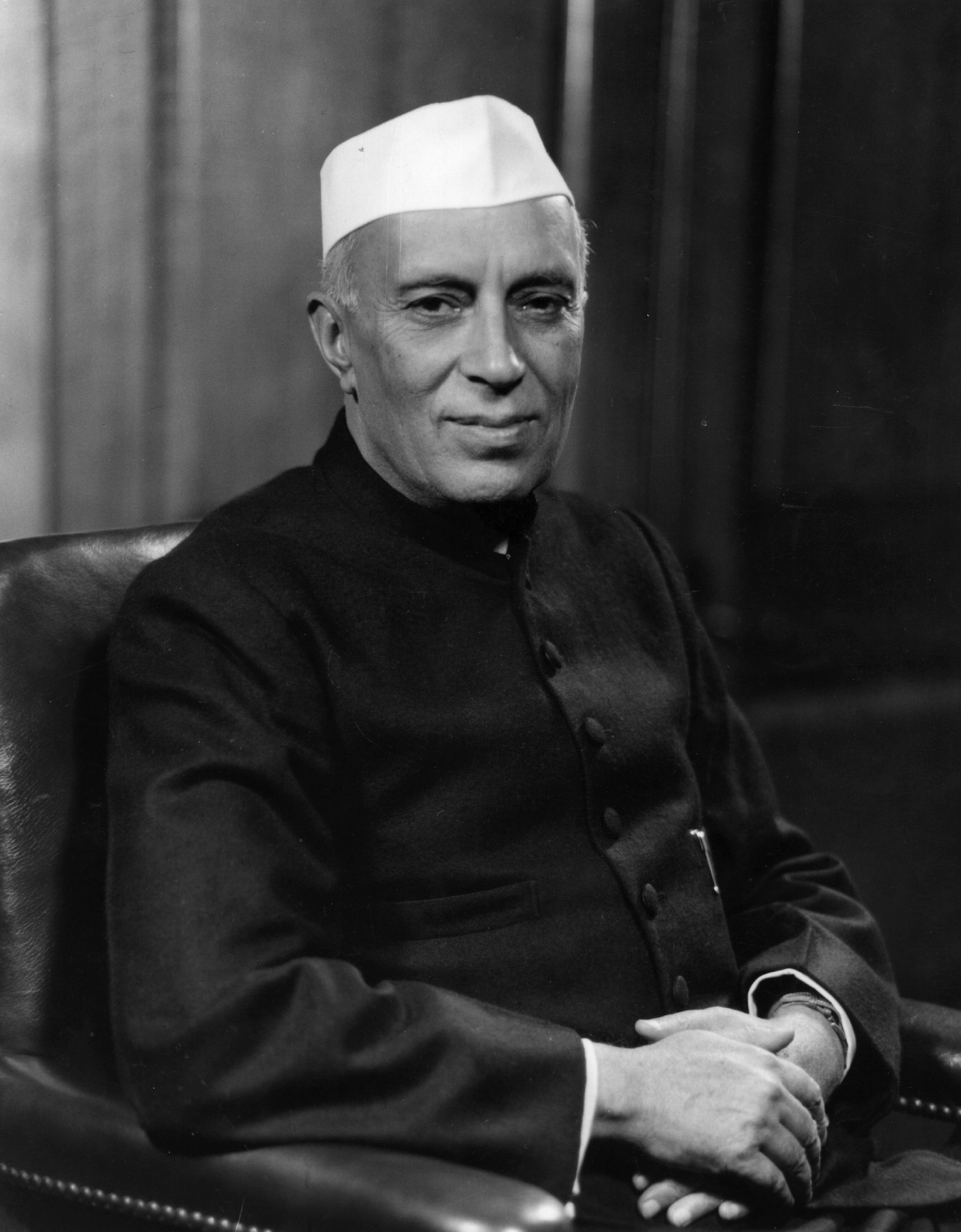
In India, Jawaharlal Nehru, a close associate of Gandhi, became the first prime minister after independence. A constituent assembly drew up a new constitution. The assembly approved the constitution in November 1949. It went into effect on Jan. 26, 1950. January 26 is now celebrated each year in India as a national holiday, Republic Day.
India in the 1950’s and early 1960’s.
India’s first general election was held in 1951 and 1952. The Congress Party, under Nehru’s leadership, won a huge majority of the seats in India’s Parliament. Nehru sought to develop the country and raise the standard of living. Under Nehru, the central government ran the economy and controlled industry.
In 1951, India began its first five-year plan, a program designed to improve the country’s standard of living. This plan resulted in some notable achievements. Agricultural and industrial production grew rapidly, and school enrollment rose sharply. A rationing system enabled people to buy essential food items at low prices. New laws made it possible for more farmers living in poverty to own the land they worked on. Women gained the right to divorce and to inherit property. Malaria was brought under control.
Nehru also sought to achieve the political unity of India. France gave up the last of its Indian territories in 1954, but Portugal refused to do so. It still had three small colonies in India—Damao (now Daman), Diu, and Goa. In 1961, Indian troops invaded these areas and defeated the Portuguese forces there. Goa became a state in 1987. Daman and Diu remained a territory.
Regional, language, and ethnic differences among Indians created difficulties for national unity. In 1953, after much pressure on the Indian government, the state of Andhra (now the states of Andhra Pradesh and Telangana) was created for Telugu speakers. In 1955, the States Reorganization Commission recommended the creation of other states based on language. At that time, the state boundaries were those that the British had drawn up. In 1956, most of India’s major language groups were given their own states. Additional states based on language were created later.
In foreign affairs, Nehru adopted a position of nonalignment. During the Cold War, a period of intense rivalry between the United States and the Soviet Union, most nations were allied with one side or the other. Nehru, however, refused to support either side. He chose to use the UN to resolve international conflicts and strongly supported UN peacekeeping operations.
Border disputes between India and China erupted into armed violence in October 1962, when Chinese forces swept into northeastern India. In November, the Chinese pulled back, and a cease-fire took effect. Nehru, who had been surprised by the Chinese invasion, decided that military spending should increase. As a result, more of the budget went to the armed forces and less to education, health, and social reform.
India under Indira Gandhi.
Nehru died in office in 1964. He was succeeded by Lal Bahadur Shastri, a member of his cabinet. In early 1965, fighting broke out along the Pakistan-India border, but Shastri and President Muhammad Ayub Khan of Pakistan quickly agreed to a cease-fire under UN supervision. There were many violations of the cease-fire, and later that year, Pakistan and India fought over Kashmir. Once again, a UN-sponsored cease-fire took effect.
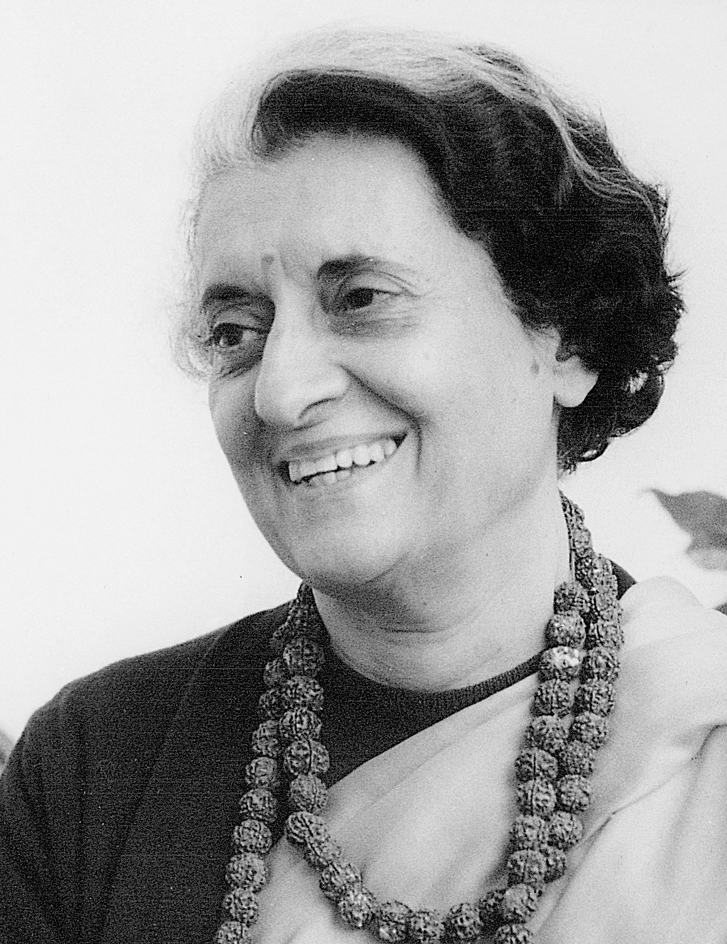
In 1966, Shastri and Ayub Khan signed a peace treaty. Shastri died shortly after signing. A brief leadership struggle within the Congress Party followed Shastri’s death. Nehru’s daughter, Indira Gandhi, eventually became the prime minister in 1966.
In 1971, civil war broke out in Pakistan, and millions of East Pakistani refugees fled into India. India assisted East Pakistan in the fight against West Pakistan. West Pakistan was defeated, and East Pakistan became the independent nation of Bangladesh.
Gandhi had taken office during widespread unrest because of severe food shortages, unemployment, and other problems. The economic situation remained poor in the early 1970’s, and there were many demonstrations urging her removal. In June 1975, a high court found Gandhi guilty of using illegal practices in her 1971 election campaign. Rather than resign, Gandhi had the president declare a state of emergency. She claimed that external enemies and internal forces of disorder were trying to break India apart. She had her opponents jailed and imposed strict censorship. In November 1975, the Supreme Court of India overturned her conviction.
In 1977, Gandhi declared the state of emergency over. Political prisoners were released, and preparations were made for elections that year. For the first time, the Congress Party lost, and the newly formed Janata Party, led by Morarji Desai, came into office. But the Janata Party, which was a coalition of several parties, could not hold itself together. Gandhi again became prime minister after her Congress-I party (the I stood for Indira) regained power in elections held in 1980.
In the early 1980’s, a militant Sikh movement grew in the Punjab. The movement’s leaders said Sikhs suffered from widespread discrimination. They wanted a separate state only for Sikhs. Some Sikhs carried out acts of terrorism against opponents of the movement. Sikh militants occupied the Golden Temple in Amritsar, the most sacred Sikh shrine. In 1984, government troops attacked the temple. The leaders of the militants died in the fighting. Many Sikhs were angry that their shrine had been attacked, and two Sikh members of Gandhi’s security force assassinated her on Oct. 31, 1984. The assassination touched off riots in which several thousand Sikhs were killed. Gandhi’s elder son, Rajiv, succeeded her as head of the Congress-I Party and as prime minister. 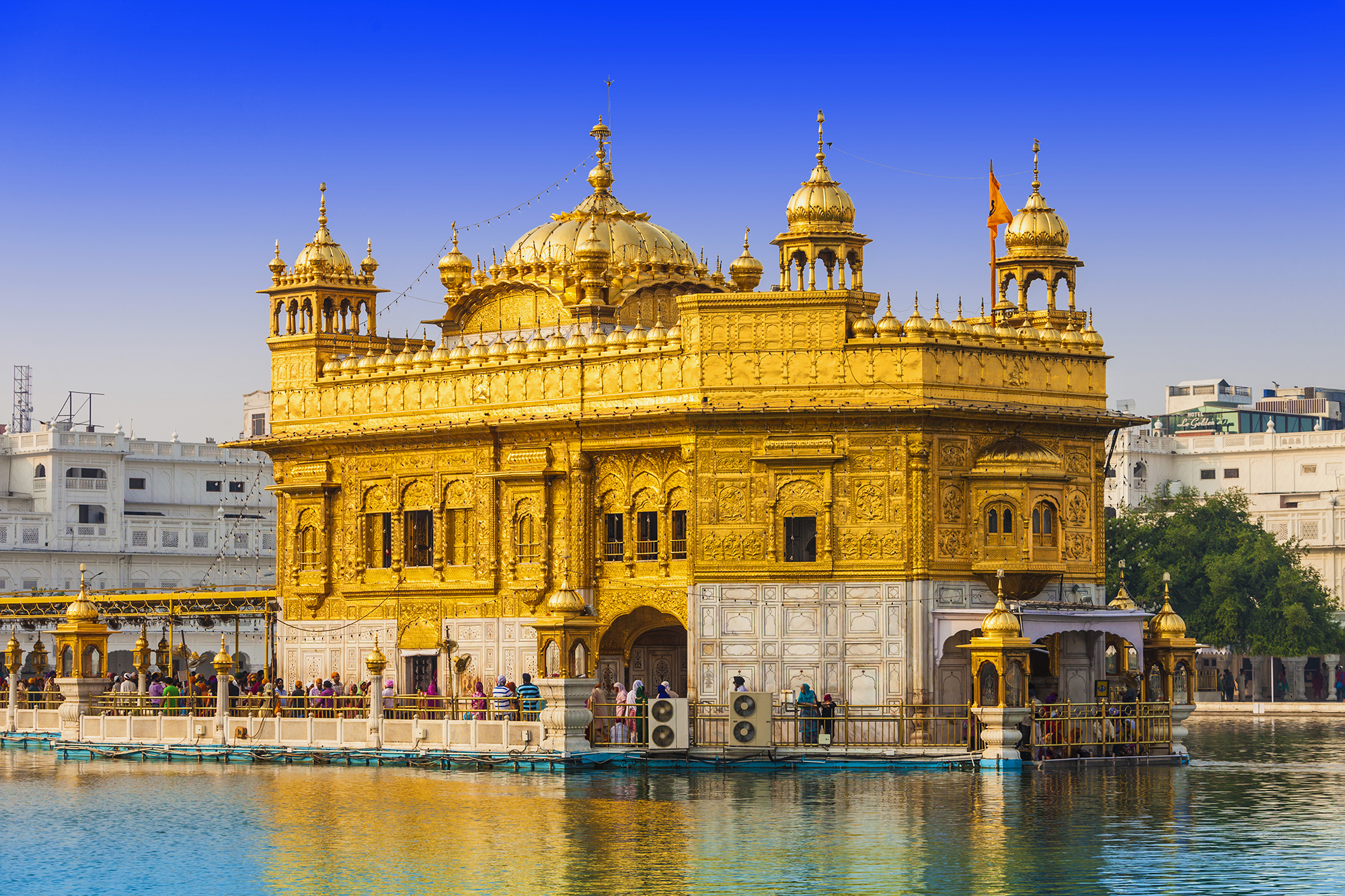
Religious and ethnic unrest.
In the late 1980’s, a number of groups in Kashmir began to hold demonstrations against Indian rule. Some groups wanted independence for Kashmir, and others wanted Kashmir to become part of Pakistan. Many groups received the support of the Pakistani government. In 1989, the demonstrations turned violent. Since then, tens of thousands of people have died as a result of clashes between Indian military forces and the opponents of Indian rule.
In 1989 and 1990, violence between Hindus and Muslims erupted over the status of a mosque (Muslim place of worship) in the town of Ayodhya in the state of Uttar Pradesh. Some Hindus claimed that a Muslim ruler of the 1500’s had built the mosque at the site after destroying a Hindu temple there. They also claimed that the Hindu god Rama was born where the mosque had been built. They demanded that the mosque be removed and a temple be built to honor Rama. In 1992, Hindu extremists destroyed the mosque. This action led to violence between Hindus and Muslims in many areas of India.
A number of ethnic separatist groups emerged in the 1980’s and 1990’s. They included the United Liberation Forces of Assam, which called for independence for Assam, and the Bodo movement, which favored autonomy for the region inhabited by the Bodo people. In 1993 and 1994, violence broke out, mainly in Manipur, between Nagas wanting independence and Kukis, who also live in the region. The clashes left hundreds of people dead and many villages destroyed.
During Rajiv Gandhi’s term, the government—and the prime minister himself—came under suspicion of corruption. In 1989, the Congress-I Party lost its majority in Parliament, and Gandhi resigned. The National Front, a coalition of parties, then formed the government. The coalition proved unable to hold together, and new elections were called. While campaigning in May 1991, Gandhi was assassinated.
The 1991 elections returned the Congress-I Party—by this time, usually called simply the Congress Party—to power. P. V. Narasimha Rao became prime minister. Rao began a far-reaching policy of reform to liberalize the Indian economy by reducing government control over it. He ended many government monopolies and introduced competition in key industries. Investment by foreign corporations in India increased dramatically.
In elections in 1996, the Congress Party suffered a major defeat. Following elections in 1998, a coalition led by the Bharatiya Janata Party (BJP), a Hindu nationalist party, came to power. Atal Bihari Vajpayee of the BJP became prime minister. This coalition collapsed in 1999. Another BJP-led coalition took power after elections later that year, and Vajpayee remained as prime minister.
In May 1998, India carried out several nuclear tests and declared itself capable of producing and using nuclear weapons. Pakistan, India’s long-time rival, responded by exploding several nuclear devices of its own.
In May 1999, Indian troops clashed with Pakistani guerrillas who had established positions inside the Indian-controlled part of Kashmir. The guerrillas were probably backed by Pakistani troops. In July 1999, the Pakistanis agreed to withdraw.
In 2000, the Lok Sabha voted to create three new states for India: Jharkhand, formed from the southern part of the state of Bihar; Uttaranchal, from northern Uttar Pradesh; and Chhattisgarh, from Madhya Pradesh. The three states came into being in November 2000. In 2006, Uttaranchal changed its name to Uttarakhand.
On Jan. 26, 2001, a powerful earthquake struck the state of Gujarat. Tens of thousands of people were killed, and many more were left homeless.
In December 2001, armed terrorists attacked India’s Parliament building. They killed or injured over 20 people, though no elected official was harmed. India blamed Pakistan for supporting the terrorists, a claim that Pakistan denied. The incident led both countries to build up military forces along their common border. In May 2002, militants in the disputed region of Kashmir attacked an Indian army base there. Troops on both sides exchanged gunfire, and the two countries came to the brink of war. International diplomacy eased the tensions. In October, both countries began pulling back troops.
Also in 2002, rioting between Hindus and Muslims in Gujarat resulted in the deaths of more than 1,000 people, mostly Muslims. The unrest was sparked by Hindu preparations to build a temple on the site in Ayodhya where the mosque had been destroyed in 1992. A 2019 decision by India’s Supreme Court eventually permitted the building of a Hindu temple at the site, and the foundation stone was laid the following year. However, the court also condemned the destruction of the mosque and ordered land to be provided for a new mosque. The new Hindu temple opened in 2024.
Recent developments.
In elections in 2004, an alliance led by the Congress Party won control of the government. Congress leader Sonia Gandhi was offered the post of prime minister, but she refused it. The post then went to Manmohan Singh, a former finance minister.

In December 2004, a powerful undersea earthquake in the Indian Ocean near the Indonesian island of Sumatra generated a series of large ocean waves called a tsunami. The tsunami’s towering waves killed about 228,000 people in areas of Asia and Africa bordering the Indian Ocean. The tsunami also left millions of people homeless and caused billions of dollars of property damage. In India, more than 16,000 people were killed along the country’s eastern and southern coasts and on the Andaman and Nicobar Islands in the Bay of Bengal.
In October 2005, a major earthquake hit north of the Pakistani city of Islamabad. More than 73,000 people were killed in northern Pakistan and in Pakistani-held Kashmir, and at least 1,300 were killed in Indian-held Kashmir. Over 3 million people were left homeless throughout the region.
In July 2006, several bombs exploded on commuter trains in Mumbai. The explosions killed more than 180 people and injured hundreds more. The Indian government accused militants based in Pakistan of playing a role in the attack.
In late November 2008, a group of terrorists launched a series of attacks against Mumbai’s main railway station, two hotel complexes, a Jewish center, and a hospital. More than 170 people, including nine gunmen, died in the three-day siege that left hundreds of others wounded. Indian authorities blamed the attack on a radical group within Pakistan. Pakistani authorities later admitted that the attacks were partially planned in Pakistan. In May 2010, the lone surviving gunman was convicted of waging war against India and other crimes. He was executed in November 2012.
In 2009, the Congress-led alliance retained control of the government. Singh remained as prime minister.
In early 2014, India prepared to create the state of Telangana by carving 10 northern districts out of the state of Andhra Pradesh. Residents of the Telangana region had campaigned for statehood for many years. They argued that development in Andhra Pradesh was focused on the southern part of the state, leaving Telangana less developed. Opponents of the plan feared that separating out the Telangana region, which includes the prosperous city of Hyderabad, would hurt the economy of Andhra Pradesh. After much heated debate, the government agreed to grant statehood to Telangana. The new state came into being on June 2.
In elections held later in 2014, the BJP won a majority of seats in the Lok Sabha. BJP leader Narendra Modi became prime minister. Widespread support for Modi and the BJP enabled the party to win another majority in the 2019 elections. Modi began a second term as prime minister. Soon after the elections, the government of India revoked the special status Jammu and Kashmir had been given when it became part of India. That status had given the state the right to have its own constitution, as well as greater control over its affairs than other Indian states have. Ending Jammu and Kashmir’s special status had long been a BJP policy goal.
The BJP-dominated Parliament then passed legislation to divide Jammu and Kashmir into two parts. The western part of the state became a union territory called Jammu and Kashmir. The eastern portion, called Ladakh, became a separate union territory. Union territories have less local authority than states do, so this action further reduced local control.
In December, Parliament passed controversial legislation that provided a pathway to citizenship for Buddhists, Christians, Hindus, Jains, Parsis, and Sikhs who had fled to India from the Muslim-majority nations of Afghanistan, Bangladesh, and Pakistan. However, the law did not include Muslims. Its passage sparked protests both from those opposed to opening citizenship to illegal immigrants and from groups who said it violated the Constitution’s guarantee of religious tolerance by discriminating against Muslims.
Beginning in 2020, India faced the challenges of the COVID-19 pandemic (global epidemic). COVID-19, a sometimes-fatal respiratory disease, first appeared in China in late 2019. The first case in India was reported in January 2020. In late March, Prime Minister Modi announced a nationwide lockdown to try to curb the disease. Schools and nonessential businesses and services were closed, and people were asked to stay at home. A large internal migration occurred as newly unemployed city workers headed back to their home villages. In early May, India’s government began to ease lockdown restrictions.
The government began a massive vaccination program in January 2021, using vaccines developed in other countries, as well as in India, to provide for the nation’s huge population. Restrictions on large gatherings were eased. By early 2023, almost three-fourths of the population had been vaccinated. Nevertheless, about 45 million cases of COVID-19 had been confirmed in India, and more than 530,000 people had died from the disease.
In late 2020, ground was broken for a new Parliament building, which was completed in 2023. The structure was part of the Central Vista project, a plan to build a number of new government buildings in New Delhi over several years.
In 2024 elections, the BJP failed to win a majority in Parliament. However, the parties making up the National Democratic Alliance (NDA), a coalition led by the BJP, won enough seats to gain a majority. As a result, Modi began a third term as prime minister. 